This, I believe, is an important question teachers must ask themselves if they are to meet the year end BC Ministry of Education Reporting Guidelines, specifically, supporting students in self-assessing their growth in the three Core Competencies: Communication, Thinking, and Personal and Social. It may be helpful to read the ministry document Supporting the Self-Assessment and Reporting of Core competencies, March 2017I have been doing this thing called teaching for over 35 years and whence I think about all the many learners, young and old, I have had the privilege to learn beside and with, I am humbled by their willingness and their abilities to take ownership of their learning and move to meaningful self-assessments when the conditions are right. What are the conditions that allow learners to assess their own learning in ways that are honest, thoughtful, and to help them move forward in their learning?
Three Essential Conditions that Support Student Self-Assessments
1. Caring Relationships
If students are to talk about their learning in honest and authentic ways, they first have to feel safe, trusted, and respected. I need to make sure that my students feel prized and cared for and that they have a sense of belonging in an inclusive learning environment. I need to help students build caring relationships with each other, as well as with me. Healthy attachments that are nurtured are important foundations to help students begin to do the difficult work of reflecting on their learning and to provide evidence that support their assessments. In short, I need to earn my students’ trust and affection so they will want to share both their thinking and feelings in sincere and personal ways.
2. Process-Orientated EngagementIf students are to reflect on, and assess their growth in the core competencies, the competencies need to be part of my classroom’s daily rhythms, routines, and curriculum activities. I have to provide opportunities for children to direct their own learning through play, inquiry, exploration, and discovery. I have to actively engage my students in rich and engaging process-orientated curriculum tasks. If students are quietly sitting in their desks, listening to teacher-talk, and completing one word answer worksheets, self-assessing their growth in the core competencies may not be an easy, nor meaningful process. Students need to take ownership of their own learning; they need to direct their own behaviour, making decisions, solving problems, working with others, communicating their ideas, and thinking creatively and critically about things that matter. In other words, students need to be living and doing the core competencies so when they are asked to assess their competencies, they can!
3. The Language of ReflectionFinally, the classroom must be a place where conversations about the process and products of learning are woven in and around the life of the classroom. If students are going to self-assess both their strengths and growth in the core competencies, students and teachers must be engaged in diverse and individualized daily interactions about learning. The language of reflection needs to be a natural and embedded part of the learning process. Right from the start of the year, I must engage students in on-going self-reflections, both informally and formally. As I do this, I can explicitly teach and model the language of the core competencies. Every day I need to provide opportunities for students to make thoughtful observations and assessments in respect of the core competencies and identify and collect evidence of their growing skills and abilities.
Teacher as Model
I need to watch and listen and, when appropriate, take time to notice, name, and connect the core competencies to the activities, experience, and learning that takes place around me. For children who do not yet have the language, I need to guide their observations through my questions, and for some, gently script their words, helping them name and describe their strengths. “Look at what you did here, communicating your ideas with such detail.” I can also model my own learning, and describe how I am demonstrating competence from my own experiences. My friend and colleague, District Principal, Antonio Vendramin, in his blog post, Silly rabbit . . . Core competencies are for everyone! shares a powerful learning story about the importance of first identifying the core competencies in ourselves before we can help our students engage in the process of self-assessment.
Research suggests that self-reflection and assessment are the most powerful instructional strategies that lead to new learning. When students are able to use their own words to describe and explain their thinking and feelings behind their learning, they become motivated and confident learners. It is my responsibility to encourage and invite students to reflect on and share what they think and feel about their learning. It is my responsibility to help students identify and collect evidence of their growing skills and abilities so that they can make thoughtful observations and assessments of the core competencies.So, the conditions are right . . .
One thing I know for sure, when the conditions are right, all learners can move to honest, thoughtful, and meaningful self-assessments. I must remember, as Sharon Jeroski, Research Director at Horizon Research and Evaluation, writes in her google doc, Supporting Self Assessment of the Core Competencies, “It’s not about filling in a template or checking off aspects on a rubric – it’s about what students are becoming and how to support them.” It really isn’t about the activity or form, and definitely not the checklist; it is instead about students taking ownership and making meaning of the process, connecting what they do, what they know, and what they feel and understand about the core competencies and how they see themselves inside these competencies.
Students Take Ownership of the Core Competencies
In many classrooms students are taking ownership of BC’s new curriculum core competencies. Teachers are bringing the core competencies to life, helping their students talk about and connect their understanding, their experiences, and their learning activities to these competencies.
All year round, students need to be engaged in the process of self-assessment. It can not just happen at the end of the year as an add on. Beyond our informal conversations and discussions of the core competencies, I also engage our students in carefully planned activities. These activities deepen students’ understanding and skill sets, and gives me feedback on the students’ growing ability to talk about and assess their strengths. Teachers have to trust and believe that children can become reflective practitioners and that every child has a voice that needs to be heard. As I have said, and written many times, it sometimes takes a lot of slow to grow.
As I plan activities that engage students in core competency work, I want to make sure they are given plenty of opportunities to:
- talk, share, and listen to each other’s ideas
- connect what they know to what they do
- communicate their understanding
- provide concrete examples and evidence of their learning
Here are some activities that we have engaged our grade 3 and 4 students to help them move to thoughtful and meaningful self-assessments of the core competencies.
Core Competency Chats
Inviting students to share their understanding of the core competencies through informal chats and discussions continues to move their growth and skills in self assessing them.
Zach shares his understanding of the Thinking Core Competency
MacKenna shares her understanding of the Communication core competency.
Avneet shares her understanding of the Personal and Social core competency.
Small Group Brainstorms
After lots of dialogue and discussion, students in small groups used felt markers (red for communication, blue for thinking, and green for personal and social) to record their understanding of the three core competencies. In pictures and/or words, students worked together to represent their ideas: What do the core competencies look like in our classroom? sound like? feel like? How would you describe the core competencies? What do they mean to you?
The insight and depth that children brought to this task was stunning. What was most interesting to me was the dialogue between the students as they worked together, negotiating, planning, clarifying, and helping each other get their ideas down. Each group began to understand how the three competencies work together and how they are interconnected in many of the activities they do. Sort and Categorize ActivityIn this activity, children worked together in small groups, first recording all the activities, routines, and tasks that they work on and have worked on. Students also gathered ideas from looking at their documentation in digital portfolios. They then made three cards with labels: communicating on red, thinking on blue, and personal and social on green; these would become their categories for the next step. One by one, the children had to talk about each “learning experience” and together choose the best category to sort it under. Once again, the dialogue was rich and descriptive as the children shared their thinking behind their decisions, coming to consensus. The children also came to realize that many of the activities and tasks we do in our classroom involve all three competencies.
As I visit other classrooms, teachers are helping students understand and self-assess competencies using “I can” statements, pictures, and photographs. Our primary classrooms have been using real photographs of children working and learning, which are talked about, competency named, and sorted similar to the example above. These strategies help lower the level of abstraction, making the language and concepts behind the words concrete and accessible to younger students. All said, even our older, more mature students need concrete examples and time to develop their understanding of the core competencies so they can move to thoughtful self-assessments. Ms. Teagan Hayes, who shares my grade 3/4 class on Thursdays and Fridays, did some wonderful work with her grade 2 class. Our kindergarten friends next door, with Ms. Becky Weber, have been collecting photos of children in action and placing them on competency posters. The young learners in this classroom are talking about the core competencies in language that makes sense to them, “We use our brains, our mouths, and our hearts, and sometimes they work all together,” the very capable little ones share. Self-AssessmentsSelf-assessments can take on many forms: photographs, videos, illustrations, learning stories, “I can” statements, open-ended writes, and more. Here are some forms that our students have used to assess their learning and plan new learning goals under the core competencies.
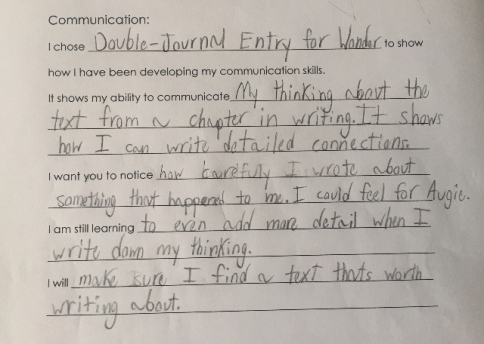
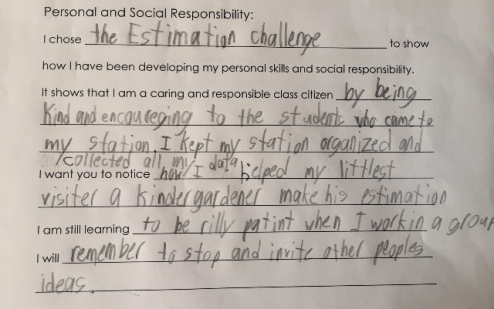
I am always reminded how real, authentic artefacts help students self-assess. Here are the photos that go alongside the above self-assessments: Paul’s Heart Collage Math Task, Samantha’s “Two of the Same” Portfolio Documentation of her Double-Entry Journal Writes, and a photo of Will manning his Estimation Challenge Station with a kindergarten visitor. “Two of the Same” explained.
And finally, a very simple and open form inviting students to share their ideas through words and/or illustrations.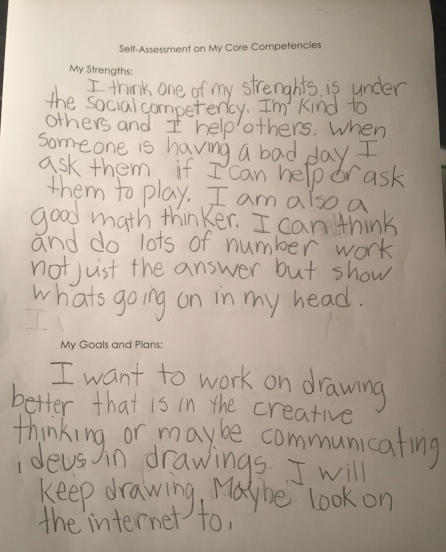

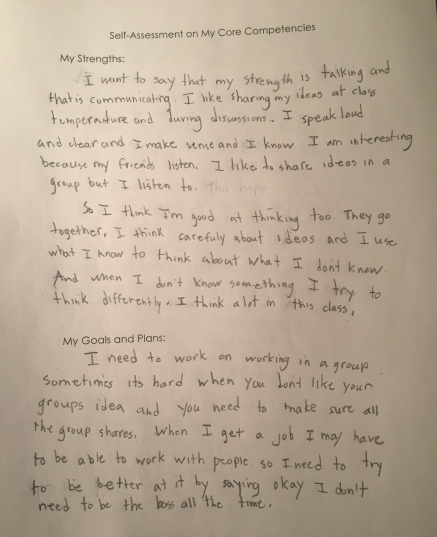
As we move into the last months of the school year, I know many teachers are focusing on helping their students move to self-assessments of the core competencies in the new curriculum. I applaud the many different ways teachers are engaging their students in the process of understanding the competencies and connecting them to their lived experiences in ways that are authentic, personal, and meaningful to them. As we continue this very important work, I am reminded of an important distinction, “A student is not a collection of competencies. A student is a person who has competencies that vary from one context to another. Competencies are all about strengths; they are not incompetencies.” (Sharon Jeroski)
I am humbled by my students’ honesty, their thoughtfulness, and their insight. When I believe in my students and give them ownership of their learning, they never cease to amaze me.

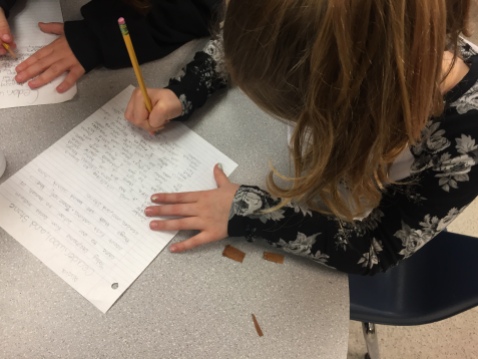
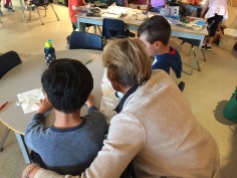




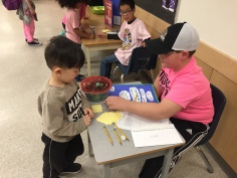




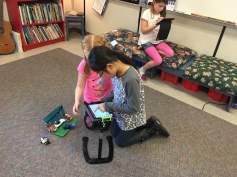














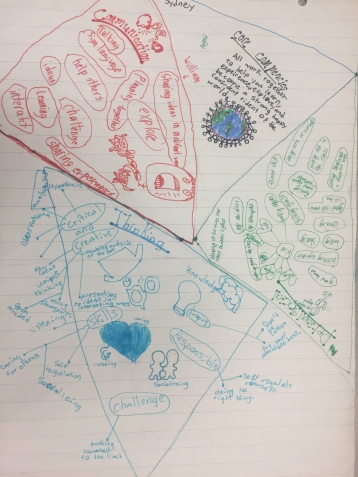



















Thanks for this, Kelly! It brings more depth to the work on core competencies and offers some sound examples. Lucky kids!
Thank you Sharon! I was going to email you to let you know I cited you and your wonderful work in this post. Take care!
KEll
Sandra Ball Inner-City Early Learning/Numeracy Helping Teacher Surrey School District #36
604-595-6061
Reblogged this on Vendramin's Views.
Wow! Thanks Kelli for in-depth sharing and examples.
Thank you Antonio for sharing Kelly’s three essential conditions that support student self-assessment. Its amazing what students can do in a safe interactive environment with a bit of creative guidance.
Hello Kelli!
Thank you so much for your post! Assessment is probably one of the most daunting and difficult things for teachers to do, especially with the new curriculum that is not so black and white. I really appreciate how you broke your activities and strategies down in detail so that we, the readers and fellow teachers, could understand how you did it and therefore recreate it for ourselves. Communicating student learning, either through online outlets like Fresh Grade, or through student self-assessments or anywhere in between, is so important, not only for teachers and parents but for the students themselves. It’s so much more rewarding to learn something when you know that you have made progress and can continue doing so!
Thank you for the videos, links, resources, and ideas.
love this and it is already being used by network educators in Nechako – how cool is that?
actually it has now reached network educators in England, Sweden, New Zealand, Australia and BC and the Yukon – so very very helpful…
Wow! I am heartened by the great work that you have documented here! Thank you for sharing!
Thank you Kelli ! I have asked my UVic students to follow your work for inspiration. Brilliant ideas! Regards, Pam (Quigg)
Thank you, Pam. They can also follow me on twitter @kellvogstad where I often communicate new posts. As I start my 36th year. I return to the classroom after 8 years in administration. I hopefully will find more time to write and may even return to SFU to teach. Thanks again for the follow and kind words.
[…] https://kellivogstad.com/2017/04/22/core-competencies-its-not-about-the-checklist/ […]
[…] CC Teacher’s Blog […]